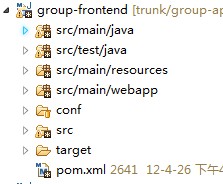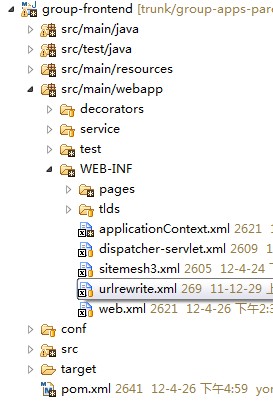Spring Junit 读取Resource、WEB-INF目录下的配置文件
来源:互联网 发布:堆排序算法实现 编辑:程序博客网 时间:2024/05/01 21:32
假设Spring配置文件为applicationContext.xml
一、Spring配置文件在类路径下面
在Spring的java应用程序中,一般我们的Spring的配置文件都是放在放在类路径下面(也即编译后会进入到classes目录下)。
以下是我的项目,因为是用maven管理的,所以配置文件都放在“src/main/resources”目录下

这时候,在代码中可以通过
- ApplicationContext applicationContext = new ClassPathXmlApplicationContext("applicationContext.xml");
如果代码想用Junit测试框架来测试,则Spring提供了对Junit支持,还可以使用注解的方式:
- @RunWith(SpringJUnit4ClassRunner.class)
- @ContextConfiguration(locations={"classpath:applicationContext.xml"})
只需要在相应的Test类前面加上此两个注解(第二个注解用来指明Spring的配置文件位置),就可以在Junit Test类使用中Spring提供的依赖注入功能。
二、Spring配置文件在WEB-INF下面
当然在做J2EE开发时,有些人习惯把Spring文件放在WEB-INF目录(虽然更多人习惯放在类路径下面)下面;或者有些Spring配置文件是放在类路径下面,而有些又放在
WEB-INF目录下面,如下图。

这时候,在代码中就不可以使用ClassPathXmlApplicationContext来加载配置文件了,而应使用FileSystemXmlApplicationContext。
- ApplicationContext applicationContext = new FileSystemXmlApplicationContext("src/main/webapp/WEB-INF/applicationContext.xml");
然后获取相应的bean。
如果代码想用Junit测试框架来测试,则Spring提供了对Junit支持,还可以使用注解的方式:
- @RunWith(SpringJUnit4ClassRunner.class)
- @ContextConfiguration(locations={"file:src/main/webapp/WEB-INF/applicationContext.xml"})
下面是我的一个Spring管理下的Junit测试类:
- package com.sohu.group.service.external;
- import java.util.List;
- import org.junit.Test;
- import org.junit.runner.RunWith;
- import org.springframework.beans.factory.annotation.Autowired;
- import org.springframework.test.context.ContextConfiguration;
- import org.springframework.test.context.junit4.SpringJUnit4ClassRunner;
- @RunWith(SpringJUnit4ClassRunner.class)
- @ContextConfiguration({"file:src/main/webapp/WEB-INF/applicationContext.xml"})
- public class SuFriendServiceImplOverRMITest {
- @Autowired
- private SuFriendService suFriendService;
- @Test
- public void getUserFollowerListTest(){
- List<String> list = suFriendService.getUserFollowerList("liug_talk@163.com");
- System.out.println("------"+list);
- }
- }
三、 使用注解引入多个配置文件
一般情况下:
- @ContextConfiguration(Locations="../applicationContext.xml")
多个文件时,可用{}
- @ContextConfiguration(locations = { "classpath*:/spring1.xml", "classpath*:/spring2.xml" })
0 0
- Spring Junit 读取Resource、WEB-INF目录下的配置文件
- Junit单元测试Spring读取classes或者WEB-INF目录下的配置文件
- Spring Junit 读取WEB-INF下的配置文件
- Spring Junit 读取WEB-INF下的配置文件
- Spring Junit 读取WEB-INF下的配置文件
- Junit单元测试Spring 读取WEB-INF下的配置文件
- Spring Junit 读取WEB-INF下的配置文件
- Junit单元测试Spring 读取WEB-INF下的配置文件
- Spring Junit 读取WEB-INF下的配置文件
- 读取web-inf目录下的spring配置文件
- Spring+Junit 读取WEB-INF上的配置文件
- Spring MVC Junit测试实例 附:读取WEB-INF下配置文件的方法
- Spring MVC Junit测试实例 附:读取WEB-INF下配置文件的方法
- Spring MVC Junit测试实例 附:读取WEB-INF下配置文件的方法
- Spring MVC Junit测试实例 附:读取WEB-INF下配置文件的方法
- Java读取WEB-INF目录下的properties配置文件
- Junit 单元测试 Spring 读取WEB-INF下 xml 文件
- Spring 读取WEB-INF配置文件
- Hdu 5172 GTY's gay friends
- 一场工厂模式的Pk
- spfa算法介绍
- SEAndroid安全机制框架分析
- hdu 5170 5171
- Spring Junit 读取Resource、WEB-INF目录下的配置文件
- 黑马程序员——类加载器、泛型、代理
- 2改变WordPress的主题
- 写程序引发的思考
- CentOS/Linux 重启网卡 活跃连接路径/network configure error错误解决
- 苦逼经历(二)
- POJ 3083 - Children of the Candy Corn(BFS+DFS)
- POJ 1811 Prime Test (miller_rabin + pollard_rho)
- 相应式布局


